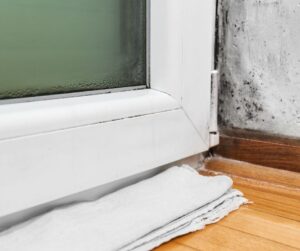A tenant's guide to
combatting condensation and mould
Welcome to our tenant’s guide on combatting condensation and mould, two familiar foes in many rented (and owned) homes across Leicester.
The good news is they are both relatively easy to deal with and prevent from becoming a problem.
We’ve used our 30+ years of experience in lettings to provide practical advice, clear explanations and proven remedies to condensation and mould problems.
Understanding the causes, identifying problem areas and implementing effective measures are crucial steps in successfully addressing these issues.
It’s also important to remember that pretty much every home in the UK, due to our climate, gets a degree of condensation and – to a varying degree – mould.
Our guide is designed to be a helpful resource, providing easy-to-follow advice, from identifying high-risk areas in your home to adopting long-term strategies to combat condensation and prevent mould growth.
We treat our tenants with courtesy and care, and this guide, like everything we strive to do as an agency, has got you (and any condensation issues) covered.
Look out for our top tips on each page of this guide – a quick-fire way to stay on top of things.

What are condensation and mould?
In this section, we delve into what condensation and mould are, why they occur and how they can impact your rental property and your tenant’s enjoyment of it. But why is condensation a concern? When excess moisture accumulates, it creates ideal conditions for mould growth. Mould, a fungus, thrives in damp, poorly ventilated areas.
It can spread quickly, causing damage to your property and, in severe cases, potentially lead to health issues, especially for those with allergies or respiratory problems.
Condensation is when warm, moist air meets a colder surface, turning water vapour into liquid. This often happens in homes during colder months (but can occur in summer, too) when heating systems are on and windows are closed, creating a perfect environment for condensation.
An important point here is not to panic – mould that causes health problems is extremely rare. This is somethingwe emphasise to tenants.
Understanding the ‘dew point’ is key. It’s the temperature at which air can no longer hold all its water vapour, causing it to to condense into water droplets. In properties, this often occurs on cold surfaces like windows or walls. Keeping indoor humidity at a balanced level is crucial in preventing the dew point from being reached inside your property.
Recognising the first signs of condensation and mould is the first step in tackling them.
From here, we will explore how to identify high-risk areas in your property and the common causes that contribute to these issues
💡 Top Tip: Install or upgrade extractor fans, especially in kitchens and bathrooms.
The places condensation and mould love
Let’s identify the common places where condensation and mould are most likely to occur on your property. Understanding these areas can help landlords and tenants focus their prevention and treatment efforts more effectively.

1. Kitchens and bathrooms
These areas are moisture hotspots due to cooking, boiling water and bathing. Without adequate ventilation, this moisture lingers and condenses on cooler surfaces
2. Cupboards and wardrobes
Tucked away and often poorly ventilated, these spaces can become mould havens, especially if they are against external walls.
3. Windows and windowsills:
Condensation frequently forms on windows, particularly during cold months, leading to mould growth on sills and frames.
4. Basements and cellars:
Often having poor ventilation and being prone to damp, these lower levels of a property are common sites for mould.
5. Behind furniture and appliances:
Areas behind large pieces of furniture or appliances, like fridges, that are rarely moved or cleaned behind, can be hotspots for mould.
6. Ceiling corners and wall joints:
These areas can harbour condensation and mould due to less air circulation.
By identifying these high-risk areas, landlords and tenants can take targeted action to reduce the development of condensation and mould.
Regular checks and maintenance of these areas are vital in preventing mould growth and maintaining a healthy living environment.
Unveiling the causes of condensation and mould
Understanding the common causes of condensation and mould is crucial in effectively combatting them. Here, we highlight the typical lifestyle and environmental factors contributing to these issues. Weeducate your / our tenants about these.
Overcrowding
More people in a space means more moisture from breathing and perspiration. The average adult releases around 400g of water daily – just by breathing.
Tumble drying and cooking
These activities can release significant moisture into the air without proper ventilation.
Lack of airflow
Poor ventilation traps moist air inside, especially in modern, well-sealed properties.
Rarely opened windows
Fresh air helps to reduce indoor humidity levels– and closed windows prevent this exchange
Drying clothes indoors
Wet clothes significantly increase indoor humidity.
Cold indoor temperatures
Warm air holds more moisture; when it cools, condensation occurs.
💡 Top Tip: Keep heating systems in good working order to ensure consistent, moderate temperatures.
A step-by-step guide to mould removal
Dealing with existing mould is crucial in maintaining a comfortable, cleaner property. This section provides a safe and effective process for cleaning mould from your rental. We share this process with tenants.

-
Safety Firsty
To be safe, wear protective gloves and googles if you feel the need to. Ensure the room is well-ventilated
-
Preparation
Remove any furniture or items near the mouldy area. Cover anything that can’t be moved with plastic sheets
-
Cleaning products
Use a mould/mildew cleaning spray or a combination of water and mild detergent. Avoid bleach as it doesn’t prevent mould from returning and can discolour surfaces. Always read the instructions.
-
Scrubbing
Gently scrub the affected area with a soft brush or disposable cloth. Be careful not to brush too hard, as this can release more mould spores into the air. When finished, put the disposable cloth straight into a bag, seal it and dispose of it to remove spores from inside the property
-
Wipe down
Wipe the area with a damp cloth to remove the mould. Ensure no residue is left behind.
-
Drying
Dry the cleaned area thoroughly. A dehumidifier can help speed up this process.
-
💡 Top Tip
Open windows for 15 minutes daily to reduce indoor moisture. And always read the instructions on cleaning products.
Quick fixes to reduce condensation and mould
There are several quick fixes that tenants can do to reduce the risk of condensation and mould immediately.
Use dehumidifiers
Portable, plug-in dehumidifiers can significantly reduce moisture levels in high-risk areas like kitchens and bathrooms.
Wipe down windows
Each morning, remove condensation from windows to prevent mould growth on sills.
Ventilate regularly
Open windows for at least 15 minutes daily to allow fresh air to circulate.
The great outdoors
Avoid drying laundry indoors without proper ventilation.
Maintain warm indoor temperatures
Consistent, moderate heating reduces the likelihood of condensation.
Rearrange furniture
Leave a gap of at least two inches between furniture and external walls to improve air circulation.
Use extractor fans
When cooking or showering, ensure extractor fans are on to remove excess moisture. And leave them running for 10-20 minutes after you finish.
Remember, it’s a tenant’s responsibility to look out for signs of condensation and take steps to manage it so it doesn’t lead to mould.
We hope you’ve found our guide to combatting condensation and mould helpful. If you have any rental property-related questions, please do not hesitate to contact our team here at Knightsbridge Professional Lettings
